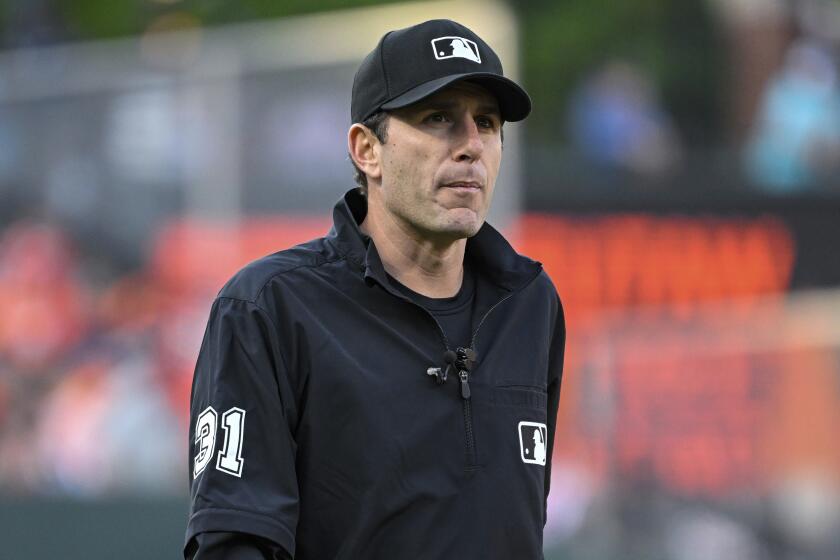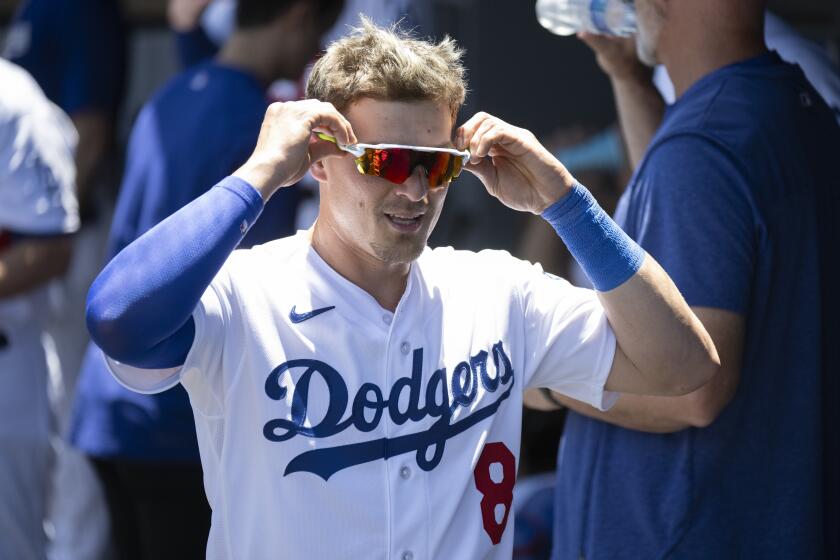With His Left-Handed Bat and Confident Manner, Bonilla Brings a New Dimension to the Dodgers
- Share via
CHICAGO — They were chanting “Bobby, Bobby, Bobby” at Dodger Stadium over the weekend, but that was nothing compared to the affection with which Bobby Bonilla has been greeted on Michigan Avenue the last two days. He and his three Florida Marlin teammates who were traded to the Dodgers came with only the suitcase they had taken on the Marlin trip, necessitating a quick shopping spree.
“Chicago is loving me right now,” Bonilla said with a smile Tuesday night. “I’ve dropped so much money.”
For the record:
12:00 a.m. May 21, 1998 For the Record
Los Angeles Times Thursday May 21, 1998 Home Edition Sports Part C Page 6 Sports Desk 1 inches; 23 words Type of Material: Correction
Baseball--Dodger third baseman Bobby Bonilla played with the Florida Marlins last season. The team was incorrect Wednesday in a chart of Bonilla’s statistics.
The man has a lot to drop, of course. Bonilla is making $5.9 million this year, the second year of a four-year $23.3-million contract signed as a free agent with the Marlins after he left the Baltimore Orioles.
There is more to Bonilla, however, than a credit card or two.
While his inclusion in Friday’s blockbuster deal is believed to have come more at the insistence of the Marlins than the Dodgers, he provides the long-absent left-handed power threat in the middle of the lineup.
“With all the wonderful right-handed hitters they’ve had, I’ve always been baffled why they’ve never had one,” the switch-hitting Bonilla said.
“The last one they had was Kirk Gibson, and that team went on to win the World Series.”
That was 1988, and Gibson won the National League’s most valuable player award.
When Bonilla batted cleanup in his Dodger debut Saturday, he was the first left-handed hitter to do so since Henry Rodriguez on July 8, 1994, a span of 536 games.
Rodriguez wasn’t the hitter then that he is now.
“[The Dodgers] were so right-handed hitting in their lineup before this that they could be shut down a bit by right-handed starters if they didn’t have enough guys going good,” Chicago Cub Manager Jim Riggleman said. “You put Bonilla’s left-handed bat in there, and it makes it a tougher lineup.”
The combination of Mike Piazza, Eric Karros, Raul Mondesi and Todd Zeile represented a formidable punch--but a limited one at times.
“Aside from a lot of speed in Mondy and the 40 points that Mike had over the rest of us in average, we were all pretty much the same hitters,” Karros said. “If a pitcher got in a rhythm nailing the outside corner, he could pretty much walk through the lineup.
“Bonilla won’t hit like Mike and may not hit as many homers as Zeile, but the threat alone may disrupt a pitcher’s rhythm and certainly could affect [an opponent’s] pitching moves late in a game.”
In addition, Karros said, with the left-handed hitter in the middle of a revamped and extended lineup, “we have more ways to score and are a threat to score in more innings. Before, we basically only scored when the middle of the lineup was up.”
Bonilla entered his 13th season averaging 22 homers and 88 runs batted in. He had a career average of .286 as a right-hander and .283 as a left-hander. He had hit 166 homers as a right-hander and 96 as a left-hander. He ranks fifth on the all-time home run list for switch hitters and ninth on the RBI list.
“He’s going to see a lot of right-handed pitchers because we’re still basically a right-handed hitting team,” Manager Bill Russell said. “Even though our right-handers have had success, the left-hander gives us a big advantage. It changes the way the opposition thinks and tends to prevent them from pitching around anyone. In this lineup, given the number of right-handed pitchers we see, he almost has to drive in a hundred runs.”
And, Russell added, with the solid and patient Gary Sheffield and Bonilla in front of him, “it should have a big impact on Mondesi” and the attempt to improve Mondesi’s discipline.
For Bonilla, the trade was a stunner.
He said he would never have expected the generally conservative Dodgers to make a deal of that magnitude. He cited their rich tradition and said he was “fired up just putting the uniform on. If that can’t fire you up, there’s always the minor leagues to kick you in the. . . . I mean, this is the perfect situation for me. The Dodgers have some youngsters [such as third baseman Adrian Beltre] coming up, but now they don’t have to rush them. I think the Dodgers knew what they were getting or wouldn’t have made the trade.”
Batting .349 over his last 18 games, Bonilla is coming off wrist and Achilles’ injuries that continue to require care but aren’t an impediment. He arrived, however, with more baggage than that one suitcase.
* He isn’t a Gold Glove at third, but neither was Zeile.
* He was voted the good guy award by the Marlin media, but others held him in less esteem.
* Baltimore Oriole General Manager Pat Gillick told The Times on Friday that Bonilla had been disruptive and a distraction because of his dislike for the designated hitter role.
In New York, where he went home to play for the Mets as a free agent after the dismantling in Pittsburgh, a series of incidents left Bonilla the focus of a tabloid feeding frenzy.
“I was so happy about playing at home that I made the mistake of saying you couldn’t knock the smile off my face, but the media kept trying,” Bonilla said. “I was considered a scumbag there, but if I can show up on the back page of the New York Daily News in diapers [after phoning the press box from the dugout to complain about a scoring decision], there’s not a lot anyone can do or say to bother me.
“It comes down to the fact that I’m not afraid to say what’s on my mind. I don’t know if that’s good or bad, but it’s the way I am.”
The most benign periods in a sometimes controversial career have come when Bonilla has played for Jim Leyland--in Pittsburgh and Florida.
Time will tell how it plays out under Russell, but the bottom line for now is that Bonilla brings an edge and ebullience to the clubhouse, that left-handed bat to the middle of the lineup and the proven and, perhaps, contagious confidence of having been to the playoffs four times, a World Series winner in ’97.
Those credit cards? Strictly a bonus.
(BEGIN TEXT OF INFOBOX / INFOGRAPHIC)
Bobby Bonilla at a Glance
YEAR BY YEAR
*--*
Year, Team AB R H 2B 3B HR RBI Avg OB% 1986, CWS-Pitt. 426 55 109 16 4 3 43 .256 .352 1987, Pitt. 466 58 140 33 3 15 77 .300 .351 1988, Pitt. 584 87 160 32 7 24 100 .274 .366 1989, Pitt. 616 96 173 37 10 24 86 .281 .258 1990, Pitt. 625 112 175 39 7 32 120 .280 .322 1991, Pitt. 577 102 174 44 6 18 100 .302 .391 1992, NYM 438 62 109 23 0 19 70 .249 .348 1993, NYM 502 81 133 21 3 34 87 .265 .352 1994, NYM 403 60 117 24 1 20 67 .290 .374 1995, NYM-Balt. 554 96 182 37 8 28 99 .329 .388 1996, Balt. 595 107 171 27 5 28 116 .287 .363 1997, Balt. 562 77 167 39 3 17 96 .297 .378 1998, Fla-LA 105 13 29 6 0 5 18 .276 .345 Totals 6,453 1,006 1,839 401 57 267 1,079 .285 .361
*--*
On the Move
Before last week’s trade, Bobby Bonilla had been traded during the season two times. Usually, the team that traded him did better without him, and the team that received him played worse. A look:
JULY 23, 1986, traded by White Sox to Pirates for Jose DeLeon
White Sox with Bonilla 42-51, .452; White Sox after trade 30-39, .434
Pirates without Bonilla 38-53, .418; Pirates after trade 26-45, .366
JULY 28, 1995, traded by New York Mets to Baltimore for Alex Ochoa and Damon Buford.
Mets with Bonilla 32-52, .381; Mets after trade 37-23, .617
Orioles without Bonilla 42-41, .506; Orioles after trade 29-32, .475
Overall Numbers
Teams that traded Bonilla:
Before the trade: 74-103 (.418)
After the trade: 67-62 (.519)
Team that traded for Bonilla:
Before the trade: 80-94 (.460)
After the trade: 55-77 (.417)
More to Read
Are you a true-blue fan?
Get our Dodgers Dugout newsletter for insights, news and much more.
You may occasionally receive promotional content from the Los Angeles Times.










